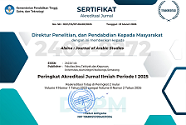Dirāsah Taḥlīlīyah lil-Ḥikam al-‘Arabīyah (Arabic Quotes) ‘alá al-Instaghrām min Manẓūr Ṭalabat Qism Ta‘līm al-Lughah al-‘Arabīyah
DOI:
https://doi.org/10.21580/alsina.5.1.22416Keywords:
Arabic leraning, Arabic quotes, Instagram, students’ perceptions, social mediaAbstract
This research aims to identify and analyze the productivity of the Quotes on Instagram @bahasaarabituindah and students' perception of its cognitive, emotional, and behavioral aspects. This research is a qualitative descriptive research and refers to the type of field research in Arabic Quotes on Instagram @bahasaarabituindah and students' perception of these Quotes. Data was collected in three ways: Observation, documentation, and questionnaire. The research findings are the productivity of the Instagram account @bahasaarabituindah in providing Arabic quotes for one semester in the 2022/2023 academic year about fifteen times per month. The categories of sentences are divided into ten: Affirmative, Negative, Command, Prohibition, Conditional, Interrogative, Begging, Wishing Sentence, Assertion, and Praying Sentence. Most students use Instagram frequently and visit general and humorous accounts. They know the accounts that offer arabic quotes but few of them know the account @bahasaarabituindah. Some students read arabic quotes from this account and find them interesting. Their favorite topic is living and they feel happy after reading the sayings. They may save quotes that suit their circumstances but few of them share them on social media. The design of Instagram @bahasaarabituindah influences the interest in reading sayings and can help increase students' vocabulary.Downloads
References
Almaany. “Ta‘rīf Wa-Ma‘ná Ḥikmah Fī Mu‘jam Al-Ma‘ānī Al-Jāmi‘ - Mu‘jam ‘Arabī ‘Arabī.” www.almaany.com, n.d. https://www.almaany.com/ar/dict/ar-ar/حكمة/.
Aloraini, Nouf, and Walcir Cardoso. “Social Media in Language Learning: A Mixed-Methods Investigation of Saudi Students’ Perceptions.” In Future-Proof CALL: Language Learning as Exploration and Encounters – Short Papers from EUROCALL 2018, edited by Peppi Taalas, Juha Jalkanen, Linda Bradley, and Sylvie Thouësny, 1–5. Research-publishing.net, 2018. https://doi.org/10.14705/rpnet.2018.26.803.
Arsyad, Azhar. Bahasa Arab dan Metode Pegajarannya. 3rd ed. Yogyakarta: Pustaka Pelajar, 2010.
Bisson, Marie‐Josée, Walter J. B. van Heuven, Kathy Conklin, and Richard J. Tunney. “The Role of Repeated Exposure to Multimodal Input in Incidental Acquisition of Foreign Language Vocabulary.” Language Learning 64, no. 4 (2014): 855–77. https://doi.org/10.1111/lang.12085.
Chaplin, J.P. Kamus Lengkap Psikologi. Jakarta: Raja Grafindo Persada, 1981.
Fajriah, Zahratun. “Peningkatan Penguasaan Kosakata Bahasa Arab (Mufradat) Melalui Penggunaan Media Kartu Kata Bergambar.” Jurnal Pendidikan Usia Dini 9, no. 1 (2017): 107–26. https://doi.org/10.21009/JPUD.091.07.
Hajirah, Azizah. Tajalliyat al-Hikmah fi Syi’r Abi Tamam Anmudhajah. Mistaghnah: Jami’ah Abd al-Hamid Ibn Idris, 2018.
Herawati, Riska, Dase Erwin Juansah, and Sundawati Tisnasari. “Analisis Afiksasi dalam Kata-kata Mutiara pada Caption di Media Sosial Instagram dan Implikasinya terhadap Pembelajaran Bahasa Indonesia di SMP.” Jurnal Membaca Bahasa dan Sastra Indonesia 4, no. 1 (2019): 45–50. https://doi.org/10.30870/jmbsi.v4i1.6236.g4379.
Humrah. Persepsi Masyarakat Desa teluk Payo terhadap Acara Warta SumSel di TVRI. Palembang: Fakultas Dakwah dan Komunikasi,Universitas islam Negeri Raden Fatah, 2017.
Irfan, Muhammad, Muhammad Najib Husain, and Ikrima Nurfikria. “Isi Pesan Dan Respon Pengguna Akun Instagram Sebagai Media Informasi Wisata.” Jurnal Ilmu Komunikasi UHO : Jurnal Penelitian Kajian Ilmu Komunikasi Dan Informasi. 4, no. 3 (2019): 86–99.
Judhita, Christiany. Transformasi System Komunikasi Model Bisnis (Ritel dan Transportasi) dari Konvensional ke Digital “KDT Komunikasi Di era Digital.” Yogyakarta: Aswaja Presindo, 2017.
Mubarak, Amin Ali Al. “Learning English as a Second Language through Social Media: Saudi Arabian Tertiary Context.” International Journal of Linguistics 8, no. 6 (2016): 112–27. https://doi.org/10.5296/ijl.v8i6.10449.
Nasrullah, Rulli. Media Sosial Perspektif Komunikasi, Budaya, Dan Sosioteknologi. Bandung: Simbiosa Rekatama Media, 2015.
Nuha, Ulin. Metodologi Super Efektif Pembelajaran Bahasa Arab. 1st ed. Yogyakarta: DIVA Press, 2012.
Nurfia, Yulia Tutik, and Miftahul Alimin. “Stilistika Nilai Edukatif Quote KHR. Ahmad Azaim Ibrahimy.” LISAN AL-HAL: Jurnal Pengembangan Pemikiran dan Kebudayaan 15, no. 2 (2021): 227–40. https://doi.org/10.35316/lisanalhal.v15i2.1615.
Nurjalia. Pengaruh Media Sosial Terhadap Prestasi Akademik Mahasiswa Program Studi Pendidikan Teknologi Informasi Fakultas Tarbiyah dan Keguruan UIN Ar-Raniry. Banda Aceh: Fakultas Tarbiyah dan Keguruan,UIN Ar-Raniry, 2018.
Pane, Akhiril. “Urgensi Bahasa Arab: Bahasa Arab sebagai Alat Komunikasi Agama Islam.” Jurnal Pengembangan Ilmu Komunikasi dan Sosial 2, no. 1 (2018): 77–88. https://doi.org/http://dx.doi.org/10.30829/komunikologi.v2i1.5452.
Pempek, Tiffany A., Yevdokiya A. Yermolayeva, and Sandra L. Calvert. “College Students’ Social Networking Experiences on Facebook.” Journal of Applied Developmental Psychology 30, no. 3 (2009): 227–38. https://doi.org/10.1016/j.appdev.2008.12.010.
Puspitayanti, Yeni. Respons Warganet di Kalangan Mahasiswa terhadap Puisi Pendek di Instagram (Studi Kasus Mahasiswa Sastra Indonesia Universitas Diponegoro Angkatan 2013-2015). Semarang: Universitas Diponegoro, 2016.
Slim, Hadoussa, and Menif Hafedh. “Social Media Impact on Language Learning for Specific Purposes: A Study in English for Business Administration.” Teaching English with Technology 19, no. 1 (2019): 56–71. https://tewtjournal.org/download/5-social-media-impact-on-language-learning-for-specific-purposes-a-study-in-english-for-business-administration-by-hadoussa-slim-and-menif-hafedh/.
Soeparno. Dasar-dasar Linguistik Umum. Yogyakarta: PT. Tiara Wacana, 2002.
Subandi, Tjipto. Penelitian Kualitatif. Surakarta: Muhammadiyah University Pers, 2006.
Sudaryat, Yayat. Makna Dalam Wacana: Prinsip-Prinsip Semantic Dan Pragmatic. Bandung: Yrama Widya, 2008.
Sujanto, Agus. Psikologi Umum. Jakarta: Aksara Baru, 1985.
Thoha, Miftah. Perilaku Organisasi Konsep Dasar dan Aplikasi. Jakarta: Rajawali, 2003.
Valenzuela, Sebastián, Namsu Park, and Kerk F. Kee. “Is There Social Capital in a Social Network Site?: Facebook Use and College Students’ Life Satisfaction, Trust, and Participation.” Journal of Computer-Mediated Communication 14, no. 4 (2009): 875–901. https://doi.org/10.1111/j.1083-6101.2009.01474.x.
Walgito, Bimo. Pengantar Psikologi Umum. Yogyakarta: CV Andi Offset, 2010.
Downloads
Published
How to Cite
Issue
Section
License
Copyright
The copyright of the received article shall be assigned to the publisher of the journal. The intended copyright includes the right to publish the article in various forms (including reprints). The journal maintains the publishing rights to published articles. Authors are allowed to use their articles for any legal purposes deemed necessary without written permission from the journal, but with an acknowledgment to this journal of initial publication.
Licensing
In order for Alsina: Journal of Arabic Studies to publish and distribute research articles, the editors need publishing rights (transferred from author to publisher). This agreement relates to the transfer/publishing copyright license to Alsina: Journal of Arabic Studies but the authors still have significant rights to use and share their published articles.
Alsina: Journal of Arabic Studies supports the need for writers to share, disseminate and maximize the impact of their research and their rights on any database. As a journal article writer, you have the right to various uses of your articles, including that by the institution or company where you work. Copyright can be used without the need for special permission. Authors who publish articles in the Alsina: Journal of Arabic Studies have broad rights to use their work for teaching and scientific purposes without requesting permission, including:
- Use by the author for lectures, presentations, or conferences, with distribution of copies to participants;
- Distribution to colleagues for research use;
- Use in compilations of the author's subsequent work;
- inclusion in a thesis or dissertation;
- Reuse of sections or excerpts from articles in other works (with full acknowledgment of the final article);
- Preparation of derivative works (other than commercial purposes) (with full acknowledgment of the final article);
- Voluntary posting on open websites operated by authors’ or writers' agencies for scientific purposes
When submitting a manuscript, authors do so on the understanding that if accepted for publication, the copyright for publishing (publishing right) of the article shall be assigned/transferred to Alsina: Journal of Arabic Studies.
Authors whose articles are accepted for publication will receive confirmation via email and sent a Copyright Transfer Agreement.


 Accreditation
Accreditation 
 In Collaboration with
In Collaboration with 

 Visitors
Visitors  Article Template
Article Template





